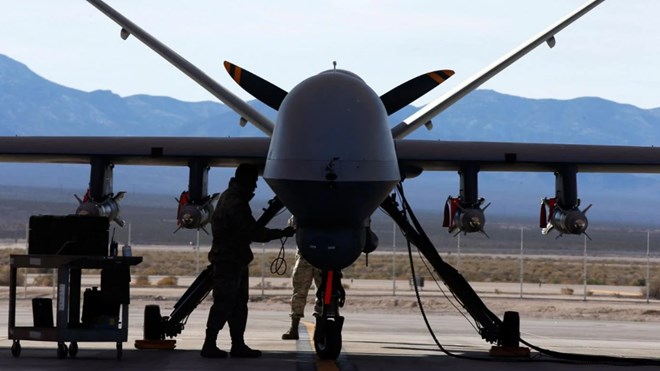
By MEE staff
Saturday November 26, 2022
Biden promised to end the 'forever wars' in the Middle East. So why did the US redeploy troops to Somalia earlier this year?
 An MQ-9 Reaper remotely piloted aircraft (RPA) in Indian Springs, Nevada. The US has conducted at least 265 air strikes in Somalia (AFP/File photo)
An MQ-9 Reaper remotely piloted aircraft (RPA) in Indian Springs, Nevada. The US has conducted at least 265 air strikes in Somalia (AFP/File photo)
Ahead of a trip to Saudi Arabia this year, US President Joe Biden said he would be the first president to visit the Middle East since 9/11 "without US troops engaged in a combat mission there".
But the lack of troops in action has not stopped the US from maintaining a military presence in the region, and one area where this is perhaps most pertinent is Somalia, a country in which the US has been engaged in a long-standing fight against militant groups.
Yet beyond the major headlines, not much is known about the exact nature of the American military operation in Somalia, an overshadowed and overlooked theatre in the US "war on terror".
MEE takes a look at why the US military is in Somalia, and what kind of military operation it's running in the Horn of Africa.What is the US doing in Somalia?
President Donald Trump's administration moved to withdraw all 700 American troops from Somalia in 2020, after a three-decade presence in the country.
Soon after the Biden administration came into office it reversed the Trump move, and in May 2022 US officials said the president approved a plan to redeploy troops to Somalia.
The reason given for the move was as a part of the Biden administration's strategy to try to reduce the threat from al-Shabab, an al-Qaeda-linked militant group that has enjoyed a resurgence in Somalia in recent years.
A US official told The New York Times that Washington was "targeting a small leadership cadre" and in particular looking to target individuals "suspected of playing roles in developing plots outside Somalia’s borders".
What does the US military presence look like?
The physical US military presence in Somalia is relatively small, numbering around 500 troops.
However, the counterterrorism operation the US is conducting is wide-ranging, and employs a tactic which has received much criticism from rights groups over the past two decades: drone warfare.
And despite the concerns raised over the use of armed drones in areas in which the US is not formally engaged in a combat mission, the Biden administration has launched a rapid pace of air strikes in the country.
In June, US Africa Command (Africom) conducted an air strike in Somalia that reportedly killed five members of al-Shabab. In July, another air strike killed two militants. A month later, Africom conducted at least five air strikes that reportedly killed 17 "al-Shabaab terrorists". In September, Africom said it killed 27 fighters in a strike.
Last month, Africom announced that it conducted an air strike that killed "one al-Shabaab leader" and that "no civilians were injured or killed". And just this month, it conducted an air strike in which Africom said it killed 17 al-Shabaab fighters.
In October, Biden signed a new classified policy to limit counterterrorism drone strikes outside conventional war zones. The new policy is meant to solidify the limits that the administration imposed early into its tenure, which served as a temporary stop-gap against the Trump administration's moves to loosen oversight.
However, Sarah Harrison, a senior fellow at the International Crisis Group, stated in a piece for Just Security that the new policy would likely have little effect on US operations in Somalia, given that it "contains loopholes that will likely allow business as usual for USAFRICOM in Somalia".
What permission does the US military have to be there?
The US Congress is the branch of the American government that has the authority to declare war.
Despite Congress not having declared war in Somalia, the Biden administration has used the 2001 Authorization for the Use of Military Force (AUMF) to bypass restrictions.
The open-ended nature of the 2001 AUMF has allowed multiple presidents to wage war against a number of groups, including al-Qaeda, the Taliban, al-Shabab, and Islamic State (IS).
It has been applied in countries including Afghanistan, Iraq, Syria, Libya, Somalia, and Yemen.
And while the Biden administration has signalled it supports ending the - different - 2002 AUMF specifically for Iraq, it has not shown any support for revoking the wider-ranging 2001 AUMF, despite calls from lawmakers.
The Somali government has recently asked the US to step up its drone strikes on al-Shabaab targets to include those "who might pose a threat to Somali forces - even if they are not firing upon them at the moment". The Biden administration is weighing the request, which would mean a significant escalation by Washington.
How is the US faring in Somalia?
In August, US defence secretary Lloyd Austin lauded the country's military operation in Africa, saying it "works alongside our friends as full partners - to strengthen bonds, to tackle common threats, and to advance a shared vision of an Africa whose people are safe and prosperous".
But a recent report from the Pentagon's Africa Center for Strategic Studies contradicted this, saying: "Militant Islamist group violence in Africa has risen inexorably over the past decade, expanding by 300 percent during this time."
In Somalia alone, the Pentagon recorded 2,221 "violent events", with battles between al-Shabaab and the country's state security forces making up 72 percent of them.
And the report noted that Somalia's al-Shabab was linked to 36 percent of all militant group violence recorded in Africa in the past year.
The US has spent roughly $2.5bn on security assistance for Somalia since 2009, according to data from the Center for International Policy. And since 2007, it has conducted at least 265 air strikes, according to Airwars.